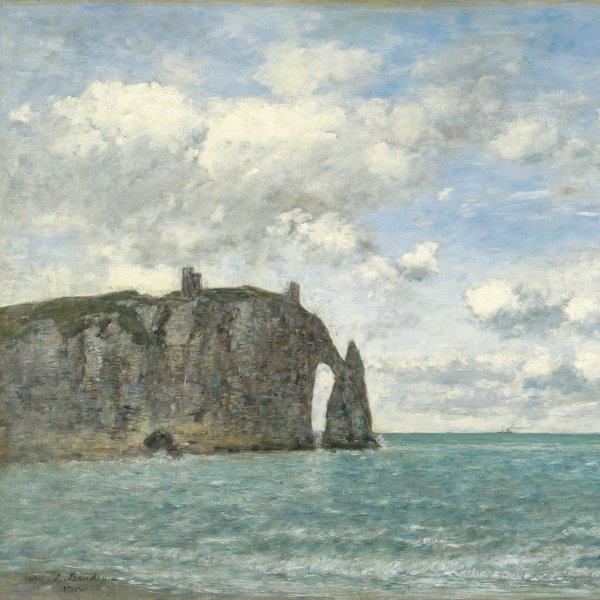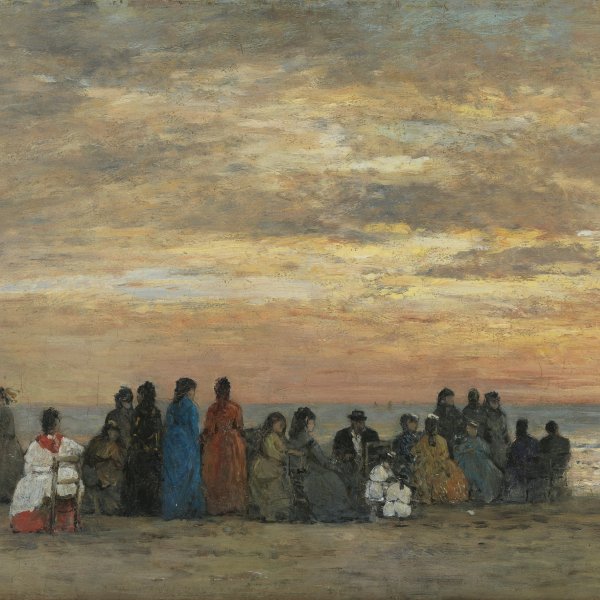Venice, The Grand Canal
1895
Oil on panel.
26 x 35.2 cm
Carmen Thyssen Collection
Inv. no. (
CTB.1998.54
)
ROOM D
Level 0
Carmen Thyssen Collection and Temporary exhibition rooms
"I regret I no longer have the years of youth needed to create a beautiful series of views of this place, which would in any case be rather difficult to paint due to the monuments, which require a good draughtsmanship and long stays in the city, like Ziem used to do in the past."
Boudin was no longer a young man when he visited Venice. His health was poor, but he insisted on painting from nature and, in the previous years, had spent the winters in the Midi in order to continue to paint out of doors. Boudin discovered Venice in 1892, and returned there in 1893 and 1894, but during those three stays he only made five paintings and probably a number of drawings.
In 1895, having familiarised himself with the light of the city, he produced, in two months, seventy-five paintings and sketches. He found there some of the light of the north, and was surprised that some painters had deformed to such a degree the atmosphere of Venice. He confided his thoughts to his dealer Durand-Ruel: Venice is "somewhat disguised by the artists who usually paint Venice, who have disfigured it by turning it into a city heated by the brightest and hottest sun. On the contrary, Venice, like all luminous cities, has a grey hue, the atmosphere is mild and misty and the sky arrays itself with clouds, just like the sky of our Norman and Dutch regions." With these words, Boudin provided an answer to the possible criticisms of those who, having in their memory Ziem's flamboyant paintings, would accuse him of not having understood the city. For some, Venice, the gateway to the East, had the colours of gold and of the sunset, while Boudin, who only trusted his own eyes, observed nature with an objective and innocent look.
The seventy-five paintings executed in 1895 are mostly composed in the same manner. They have a frontal point of view, the subject takes up the most distant ground, while before the eyes of the beholder stretches the water of the Grand Canal with the gondolas sailing along. Boudin chose the best known views: la Salute, the Doge's Palace, the Giudecca. Occasionally, he wandered into the less popular areas. Half a dozen works offer a variant of this composition: a building fills the left-hand side of the painting, while an oblique quay introduces a dynamically rising line; large sailing boats take up the centre of the picture. In such works, the architecture of Venice is substituted by the boats.
Such is in fact the composition of this painting from the Carmen Thyssen-Bornemisza Collection. Two sailing boats are the central subject and Venice is only a backdrop. The brushstroke is lively and light, like a sketch. The marks left by the brush on the paint are long and horizontal, and they suggest, rather than outline, the subject. The gondola close to the quay is depicted with a few lines, and glides effortlessly over the water. The gondolier is only a sketched silhouette, but the painter's strokes are enough to convey a sense of movement and the position of his body. The three seated figures are represented with yellow and red patches of colour. The artist's acute eye and sensitivity are revealed in these unimportant details, which testify to his constant search for truth, for the essential and the instantaneous. The sky resembles the Norman skies full of fleecy clouds with leave little space to the light blue hues. The sailing boats could be in the ports of Deauville or Le Havre, but the gondola enables us to identify the scene. This work is the exact application of Boudin's views mentioned above: Venice, with its misty and damp atmosphere, can evoke his well-known Normandy.
In spite of his age and poor health, the artist remained active until the end. Boudin confided to his friend the painter Braquaval in May 1896: "my trip to Venice will have been my swansong."
Anne-Marie Bergeret-Gourbin
Boudin was no longer a young man when he visited Venice. His health was poor, but he insisted on painting from nature and, in the previous years, had spent the winters in the Midi in order to continue to paint out of doors. Boudin discovered Venice in 1892, and returned there in 1893 and 1894, but during those three stays he only made five paintings and probably a number of drawings.
In 1895, having familiarised himself with the light of the city, he produced, in two months, seventy-five paintings and sketches. He found there some of the light of the north, and was surprised that some painters had deformed to such a degree the atmosphere of Venice. He confided his thoughts to his dealer Durand-Ruel: Venice is "somewhat disguised by the artists who usually paint Venice, who have disfigured it by turning it into a city heated by the brightest and hottest sun. On the contrary, Venice, like all luminous cities, has a grey hue, the atmosphere is mild and misty and the sky arrays itself with clouds, just like the sky of our Norman and Dutch regions." With these words, Boudin provided an answer to the possible criticisms of those who, having in their memory Ziem's flamboyant paintings, would accuse him of not having understood the city. For some, Venice, the gateway to the East, had the colours of gold and of the sunset, while Boudin, who only trusted his own eyes, observed nature with an objective and innocent look.
The seventy-five paintings executed in 1895 are mostly composed in the same manner. They have a frontal point of view, the subject takes up the most distant ground, while before the eyes of the beholder stretches the water of the Grand Canal with the gondolas sailing along. Boudin chose the best known views: la Salute, the Doge's Palace, the Giudecca. Occasionally, he wandered into the less popular areas. Half a dozen works offer a variant of this composition: a building fills the left-hand side of the painting, while an oblique quay introduces a dynamically rising line; large sailing boats take up the centre of the picture. In such works, the architecture of Venice is substituted by the boats.
Such is in fact the composition of this painting from the Carmen Thyssen-Bornemisza Collection. Two sailing boats are the central subject and Venice is only a backdrop. The brushstroke is lively and light, like a sketch. The marks left by the brush on the paint are long and horizontal, and they suggest, rather than outline, the subject. The gondola close to the quay is depicted with a few lines, and glides effortlessly over the water. The gondolier is only a sketched silhouette, but the painter's strokes are enough to convey a sense of movement and the position of his body. The three seated figures are represented with yellow and red patches of colour. The artist's acute eye and sensitivity are revealed in these unimportant details, which testify to his constant search for truth, for the essential and the instantaneous. The sky resembles the Norman skies full of fleecy clouds with leave little space to the light blue hues. The sailing boats could be in the ports of Deauville or Le Havre, but the gondola enables us to identify the scene. This work is the exact application of Boudin's views mentioned above: Venice, with its misty and damp atmosphere, can evoke his well-known Normandy.
In spite of his age and poor health, the artist remained active until the end. Boudin confided to his friend the painter Braquaval in May 1896: "my trip to Venice will have been my swansong."
Anne-Marie Bergeret-Gourbin









